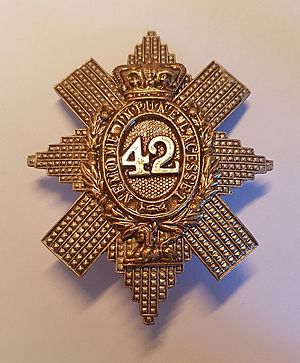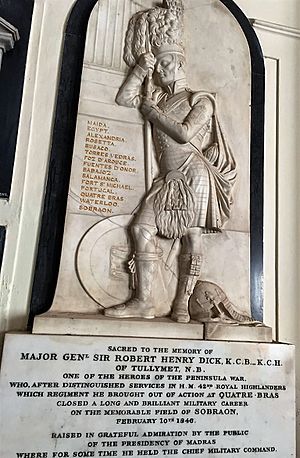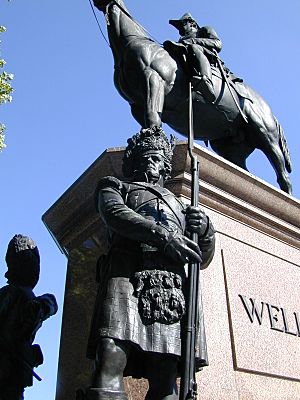42nd Regiment of Foot facts for kids
Quick facts for kids 42nd (Royal Highland) Regiment of Foot |
|
|---|---|

Cap badge of the 42nd Regiment of Foot
|
|
| Active | 1739–1881 |
| Country | |
| Branch | |
| Type | Line Infantry |
| Garrison/HQ | Queen's Barracks, Perth |
| Nickname(s) | Black Watch Forty-Twa Black Jocks |
| Motto(s) | (Scotland's) Nemo me impune lacessit |
| Engagements | |
| Battle honours | |
The 42nd (Royal Highland) Regiment of Foot was a famous Scottish infantry regiment in the British Army. It was also known as the Black Watch.
This group was first called Crawford's Highlanders in 1739. In 1748, it became the 42nd Regiment. It was officially named the 42nd (Highland) Regiment of Foot in 1751. The 42nd Regiment was one of the first Highland groups to fight in North America. In 1758, it earned the special name Royal Highland Regiment. Its informal name, Black Watch, became official in 1861.
In 1881, the regiment joined with another unit. This was part of army changes called the Childers Reforms. The new group was named The Royal Highland Regiment (The Black Watch). In 1931, it was renamed The Black Watch (Royal Highland Regiment). Finally, in 2006, the Black Watch became part of the Royal Regiment of Scotland.
Contents
History of the Black Watch
Early Days of the Regiment

After a rebellion in 1715, the British government needed to keep order in the Scottish Highlands. They recruited men from local Highland clans who were loyal to the government. These groups were called Independent Highland Companies.
In 1725, General George Wade created these companies to stop crime, especially cattle theft. He also built roads to help them. These companies were known as Am Freiceadan Dubh, or the Black Watch. This name might have come from their dark uniforms.
By 1739, ten Independent Highland Companies existed. They officially formed the "43rd Highland Regiment of Foot". The regiment first gathered in 1740 in Aberfeldy, Scotland.
First Battles and a Mutiny
In March 1743, the regiment was sent to London. They were told they would join British forces fighting in Flanders. Scottish officials warned this was against what the soldiers expected. They thought they would only serve in Scotland.
When ordered to sail to Flanders, the soldiers were angry. They heard rumors they were going to the West Indies, a place known for sickness. This led to a mutiny. Three leaders were executed, and many others were sent to distant garrisons.
The regiment's first major battle was the Battle of Fontenoy in May 1745. They fought fiercely and impressed their commander. They were allowed to fight "their own way".
During the Jacobite rising of 1745, some new companies were formed. One company fought at the Battle of Prestonpans and was captured. Another fought at the Battle of Culloden. After the rebellion, the regiment was stationed in Ireland until 1756. In 1749, they were re-numbered as the 42nd Regiment.
Fighting in the Americas
During the French and Indian War, the regiment fought at the Battle of Carillon in July 1758. They lost more than half their men. By this time, they were officially a Royal regiment.
The 42nd Regiment also fought at the second battle of Ticonderoga in 1759. They were present when Montreal surrendered in 1760. They also saw action in the Caribbean at Havana, Martinique, and Guadeloupe.
From 1758 to 1767, the 42nd served in America. In 1763, they fought in the Battle of Bushy Run. This was to help Fort Pitt during Pontiac's Rebellion. The regiment returned to Scotland in 1775.
During the American Revolutionary War, the regiment was involved in many battles. These included the Battle of Long Island (1776) and the Battle of Fort Washington (1776). They also fought at the Battle of Brandywine (1777) and the Battle of Monmouth (1778). In 1778, a part of the regiment raided Fairhaven, Massachusetts.
After the war, the 42nd was sent to Nova Scotia in 1783. They returned to England in 1789 and then moved to Scotland.
French Revolutionary Wars
On March 8, 1801, the 42nd took part in the Battle of Aboukir. This was a big victory for the British. The troops landed under heavy French fire. They formed a line and charged with bayonets.
The 42nd struggled up a sandy hill. French soldiers fired at them from the top. The lead troops of the 42nd reached the top and charged, pushing the French back. The French tried a cavalry attack, but another charge by the 42nd made them flee. The 42nd Highlanders had 31 killed and many wounded.
The Battle of Aboukir allowed the British to move forward. Thirteen days later, they fought the Battle of Alexandria. The 42nd helped capture a French flag during this battle. They then helped besiege Cairo and Alexandria. This forced the French out of Egypt.
The Peninsular War

In August 1808, the 1st battalion went to Portugal for the Peninsular War. At the Battle of Corunna in January 1809, a 42nd Highlander carried the wounded General Sir John Moore to safety. The Black Watch played a big part in this victory.
As the 1st battalion left, the 2nd battalion arrived in Spain. The 2nd battalion fought at the Battle of Bussaco in September 1810. They also fought bravely at the Battle of Fuentes de Oñoro in May 1811. They were involved in the siege of Ciudad Rodrigo and the siege of Badajoz in 1812.
The 1st battalion returned to the Peninsula. They fought in the Battle of Salamanca in July 1812. They also fought at the siege of Burgos and the Battle of Vitoria in 1813. They then chased the French into France. They fought at the Battle of the Pyrenees, Battle of Nivelle, and Battle of the Nive. Their last battles in this war were Battle of Orthez and Battle of Toulouse in 1814.
The Battle of Waterloo
After the war with France seemed over, the 2nd battalion was disbanded in 1814. Some of its soldiers joined the 1st battalion. The now single 42nd battalion fought at the Battle of Quatre Bras on June 16, 1815. Their leader, Lieutenant-colonel Sir Robert Macara, was killed.
The 42nd was praised by Wellington for their bravery. Two days later, at the Battle of Waterloo, the 42nd and the 73rd Highlanders were in the thickest fighting.
The Victorian Era
From 1847 to 1851, the regiment was stationed in Bermuda. This was an important British military base. The 42nd Regiment helped clear land for a new army camp. They also dug a well near the Governor's house during a drought. This well is still known as Black Watch Well. A road nearby, Black Watch Pass, is also named after them.
The regiment was part of the Highland Brigade during the Crimean War. They fought at the Battle of Alma in September 1854. They also took part in the siege of Sevastopol in 1854.
During the Indian Rebellion, they fought at the siege of Cawnpore and the siege of Lucknow in 1857. At Cawnpore, the regiment captured a gong. This gong has tolled the hours in the regiment's guardroom ever since.
In the 1870s, army changes linked regiments together. The 42nd joined with the 79th Regiment. On July 1, 1881, the 42nd Regiment officially joined with the 73rd (Perthshire) Regiment of Foot. They formed the Black Watch (Royal Highlanders).
Popular Culture
Many songs were written about the regiment. These include "Jock MacGraw" and "The Gallant Forty Twa".
The song "The Baltic tae Byzantium" by Brian McNeill mentions "The Gallant Forty Twa".
The traditional Scots song "Twa Recruitin' Sergeants" talks about recruiters trying to get Highlanders to join the regiment.
Gregory Burke's 2006 play Black Watch is about the regiment's role in Operation Telic. It uses the songs The Gallant Forty Twa and Twa Recruitin' Sergeants.
Notable Soldiers
- James Abercrombie
- Duncan Cameron
- John Small
- John Grant
Battle Honours
These are the special awards the regiment earned for its battles:
- Egypt
- Peninsular War: Corunna, Fuentes D'Onor, Pyrenees, Nivelle, Nive, Orthes, Toulouse, Peninsula
- Waterloo
- Crimean War: Alma, Sevastopol
- Indian Mutiny: Lucknow
- Ashanti Wars: Ashantee 1873-74
- Guadaloupe 1759, Martinique 1762, Havannah (awarded to successor regiment, 1909)
- Busaco, (awarded to successor regiment, 1910)
- North America 1763-64, (awarded to successor regiment, 1914)
- Salamanca, (awarded to successor regiment, 1951)
Victoria Crosses
These soldiers from the regiment received the Victoria Cross, a very brave award:
- Private Walter Cook, Indian Mutiny (15 January 1859)
- Private James Davis, Indian Mutiny (15 April 1858)
- Lieutenant Francis Farquharson, Indian Mutiny (9 March 1858)
- Colour Sergeant William Gardner, Indian Mutiny (5 May 1858)
- Lance-Sergeant Samuel McGaw, First Ashanti Expedition (21 January 1874)
- Private Duncan Millar, Indian Mutiny (15 January 1859)
- Quartermaster Sergeant John Simpson, Indian Mutiny (15 April 1858)
- Private Edward Spence, Indian Mutiny (15 April 1858)
- Lance Corporal Alexander Thompson, Indian Mutiny (5 April 1858)
Regimental Colonels
These were the Colonels who led the Regiment:
- 1739–1741: Lt-Gen. John Lindsay, 20th Earl of Crawford
- 1741–1745: Brig-Gen. Hugh Sempill, 12th Lord Sempill
- 1745–1787: Gen. Lord John Murray
42nd (Royal Highland) Regiment of Foot - (1758)
- 1787–1805: Gen. Sir Hector Munro, KB
- 1806–1820: Gen. George Gordon, 5th Duke of Gordon, GCB (Marquess of Huntly)
- 1820–1823: Gen. John Hope, 4th Earl of Hopetoun, GCB
- 1823–1844: Gen. Sir George Murray, GCB, GCH
- 1844–1850: Lt-Gen. Sir John Macdonald, GCB
- 1850–1862: Gen. Sir James Dawes Douglas, GCB
- 1862–1863: F.M. George Hay, 8th Marquess of Tweeddale, KT, GCB
42nd (Royal Highland) Regiment of Foot, The Black Watch - (1861)
- 1863–1881: Gen. Sir Duncan Alexander Cameron, GCB





